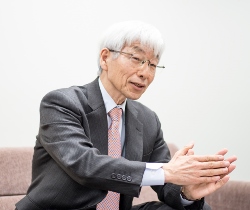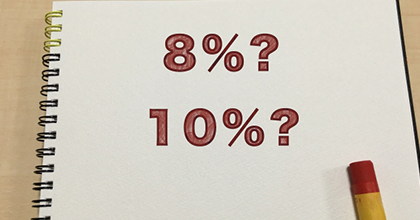Reduced Tax Rate is Not All Good News

By introducing the reduced tax rate to the consumption tax, Japan will transition from what used to be a single tax rate to multiple tax rates. In the newspaper and on television, there are numerous reports on different countries having varying reduced tax rate policies, some with reduced tax rate on foodstuffs. This gives off the impression that Japan is just joining the world standard, but in reality the present common understanding in the world is that it is better not to use multiple tax rates; the tide is favoring the unification of the tax rates. Japan is the first in the world to go from a single tax rate to multiple tax rates. The reason why a single tax rate is better is the difficulty in defining clearly what constitutes foodstuffs. In Japan, even if a line is drawn once, there will inevitably be various practical problems such as making a determination for each individual product.
The reduced tax rate poses another big problem. It will bring about a large decrease in tax revenue. As a countermeasure, raising the standard tax rate will be examined. In Europe, there is a country with a standard tax rate of 27%. There is no telling what the consumption tax rate in Japan will be in the future.
On the other hand, the merit of introducing the reduced tax rate is the improved image of the consumption tax as being regressive. Compared to high income earners, low income earners have a proportionately larger food expense, to which a reduced tax rate will no doubt bring a tremendous benefit. Furthermore, regardless of income, anyone would be happy to pay less in taxes, so there may be a lot of people welcoming the reduced tax rate on foodstuffs.
However, the introduction of the reduced tax rate became an opportunity to generate a further merit. That is the introduction of the tax calculation method called the invoice method.
The Big Change as a Result of the Reduced Tax Rate
It was in 1989 when a consumption tax was introduced in Japan. It’s been 27 years since, but other than businesses, there may be a very few people who understand the mechanism of consumption tax to its full extent. For example, when purchasing a product, it is thought that the 8% tax on the product paid to the business is directly paid to the tax authority by the business, but that is not the case. The superior mechanism of consumption tax is in being able to deduct the tax amount on purchase from supplier from the tax amount on sales to avoid cascade tax. However, the book method, unlike in foreign countries where the invoice method is used, is the method of calculating this purchase tax credit in Japan. This distorts the image and consumption tax is seen as a tax on the difference between revenue and expenditure.
For example, when business A purchases a product from business B for 700 and sells it to a consumer for 1000 (assuming all prices herein are exclusive of tax), 1000-700=300 multiplied by the tax rate of 8% comes out to 24, which is the tax amount owed. If business B had purchased the product from business C for 500, the tax amount owed would be 16 (700-500=200 multiplied by 8%). Assuming that business C is the raw material producer and did not purchase any supply, 40 (500-0=500 multiplied by 8%) would be the tax amount owed. The tax amount paid by these three parties, 24+16+40=80, is equivalent to the consumption tax to be paid by the consumer at 80 on a product that costs 1000.
However, this calculation method had a problem. If business B had been a tax exempt business, business A, because the tax amount is not included in the purchase price, could not apply the purchase tax credit, therefore the tax amount should increase proportionally. But with the book method, all purchases are deemed to have the tax amount included, thus there is no separate consideration given for the above exemption. That is to say, the tax credit is applicable to purchases in which the tax amount is not included, thereby generating a profit from unpaid tax.
To counter this, foreign countries like those in Europe use the invoice method; an invoice is issued on individual transactions clearly indicating the tax amount and the tax amount owed by a business is calculated based on the tax amount shown on the invoice. Taking the aforementioned example, the tax amount on the sale of business A is 1000 multiplied by 8%, which is 80. And because the tax amount indicated on the invoice issued by the supplier, business B, is 700 multiplied by 8%, which is 56, the tax amount owed by business A is 80-56=24. The tax amount owed by business B is 56-40=16, in which 40 is based on the invoice of business C (500 multiplied by 8%). If business B is an exempt business, an invoice is not issued and business A is unable to apply the purchase tax credit. The invoice method makes it more difficult to generate profit from unpaid tax.
The invoice method is to be introduced in 2021 accompanying the introduction of the reduced tax rate in 2017. The reason why the reduced tax rate became the cue for the introduction of the invoice method is because the book method is in fact incompatible with multiple tax rates. The decision to introduce the invoice method, which is compatible with multiple tax rates, came rather unexpectedly. However, the introduction of the invoice method might be the biggest merit to introducing multiple tax rates in terms of fairness and transparency in taxation, as well as competition neutrality between businesses.
Japan’s Purchase Tax Credit is Still Unfair

The introduction of the invoice method is expected to resolve visible unfairness. Japan’s purchase tax credit, however, still has problems. Businesses are able to apply the purchase tax credit to anything they want, such as dining at an expensive restaurant, purchasing a luxury car, etc., as long as they are recorded as expenses. This is unfair to general consumers, who are always paying consumption tax.
The truth is, in 1990, a plan was examined to reform the tax system from the standard tax rate of 3% for the consumption tax at the time to the reduced tax rate of 1.5% for foodstuffs. During that time, an idea popped up to exclude social expenses and the purchase of luxury cars by businesses from the purchase tax credit as a countermeasure against tax revenue decrease. Although the revision of the purchase tax credit was thrown out because the plan for the reduced tax rate did not come to fruition, now that the introduction of the reduced tax rates is official we should limit the purchase tax credit and examine how to tax extravagant spending. This type of limitation on purchase tax credit is widely promoted in Europe. This supplements tax revenue decrease as well as rectifying the tax system so as to avoid unfairness.
The real burden of a consumption tax falls on the consumers, and the role of businesses is to shoulder the work of tax payment as agents of the tax authority. The mechanism by which businesses receive excessive preferential treatment should be reconsidered, and the issues regarding the execution of the application of the reduced tax rates should be solved through the cooperation of businesses and the taxing authority.
* The information contained herein is current as of February 2016.
* The contents of articles on M’s Opinion are based on the personal ideas and opinions of the author and do not indicate the official opinion of Meiji University.
Information noted in the articles and videos, such as positions and affiliations, are current at the time of production.


